Jalsu Pass lies hidden amidst the majestic Dhauladhar range, at an altitude of around 3700 meters. Jalsu Pass pass serves as a vital connecting link between the picturesque valleys of Kangra and Chamba in the state of Himachal Pradesh. For ages, the indigenous Gaddi tribe of Himachal has traversed this pass, relying on its ancient trails to journey between these two scenic valleys.
Jalsu Pass, fondly referred to as the “flower valley” of Himachal Pradesh, is a mesmerizing testament to the untouched beauty that can still be found in the Himalayan region. Despite its breathtaking allure, Jalsu Pass remains hidden from the bustling crowds, providing an untouched paradise for those who venture to explore its mesmerizing landscapes.
In this article, we delve into the captivating wonders that await in the secret realm of Jalsu Pass, inviting you to join us on a journey of discovery through this hidden treasure of nature’s splendor.
Jalsu Pass Trek
In June of last year, me and my two friends decided to go on a trek to Jalsu Pass. Honestly, we weren’t very thrilled about it because we had heard numerous stories from people in our village and nearby areas who had already crossed over to Chamba through Jalsu Pass. It felt like a familiar experience for us, nothing special. Little did we know that this trek would create everlasting memories for us and would surprise us with its serene beauty.
Jalsu Pass Trek Day 1 : Home to Bakhlud
Jalsu Pass trek starts at Binwanagar, which is a hydro project site located near Utrala village. You can reach Binwanagar by driving your own vehicle or taking a bus or taxi from Baijnath or Paprola. It’s approximately 12 kilometers away from Baijnath.
From Binwanagar, the Forebay (Talaai) is just 3-4 kilometers away, and this is where the actual trek starts. You can easily access the Forebay, through a connected road.
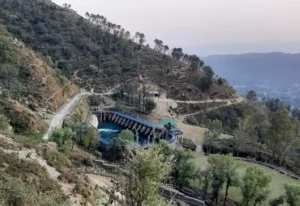
We started our journey from our village close to Utrala. Our adventure kicked off at 5 PM as we departed our homes. It took us approximately an hour to reach the Forebay(Talaai). After parking our bikes there, we began our walk towards Bakhlud. The walk to Bakhlud took about an hour and a half. The path to Bakhlud was steep in the first half, but the second half was easier to manage.
By 7 PM, we arrived at Bakhlud, and luckily, there was still a lot of daylight left. Our plan was to stay the night there, so we settled into a cozy hut nestled beneath a massive stone. These huts are set up by the locals from May to October, the peak season, and they offer affordable accommodation and meals for trekkers like us.
While in Bakhlud, we had a chat with the friendly owner. He shared valuable insights about the trail and helped us get mentally prepared for the Jalsu Pass trek . Surprisingly, the night in the hut was really comfortable, and we got a good rest, recharging ourselves for the journey ahead.

Jalsu Pass Trek Day 2 : Bakhlud to Jalsu Pass
Bakhlud to Parai
The next morning, we woke up at 6 am and began our trek towards Jalsu Pass at 6:30. I was excited for today’s journey because the actual trek was starting. Our destination was quite far for the day. After walking for about two hours, we reached the riverside. Until then, we had been passing through thick forests, with only the sound of the river audible.
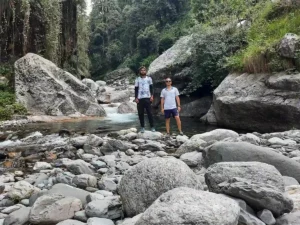
We took a break by the river and cooked Maggi since we hadn’t eaten breakfast earlier. After enjoying our meal and taking some photos, we resumed our trek. The path so far had been mostly straight without any uphill climbing. However, ahead of us, there was an uphill stretch we needed to tackle.
From this point onward, the trail followed the river. It was June, and the sun was beating down on us, making us feel even more tired. As we walked, we arrived at a spot where the river had formed a pond. The water was a deep blue and incredibly clear. Unable to resist, we decided to take a refreshing swim.

After spending about half an hour in the river, we continued towards Parai. After covering some distance, we encountered a shop where we could take a break and grab some refreshments. We chose to keep going, feeling that we were already a bit behind schedule.
Another hour of walking brought us to Parai. We entrusted our belongings to the only shop in Parai and took in the breathtaking natural beauty of the place. Parai, nestled in the embrace of the massive Dhauladhar range, marked the meeting point of two streams. These streams converged to form Parai Nala.
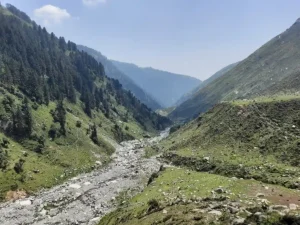
This Parai Nala joins the Binnu Nala near Tar village and they are collectively make Binwa River. After having lunch and resting for about an hour in Parai, we inquired about the route ahead from the shop owner. He presented us with two options: one was via Chunji Top, a steep but shorter route, and the other was via Kharli, a longer but more straightforward path.
Opting for the shorter route, we set off for Jalsu Pass.. Unfortunately, this decision turned out to be a significant mistake on our part.
Parai to Jalsu Pass via Chunji Top
Around 2 o’clock, we left Parai and continued towards Chunji Top. Chunji in pahari literally means “Peak” The path to Chunji Top was incredibly steep, and it turned out to be a big mistake to choose this route. Just 15 minutes of walking on this path left us utterly exhausted. Each step was a struggle, and we had to stop every ten steps to catch our breath.
For anyone attempting this route, having a precise understanding of the path is crucial. Since there’s no established trail due to the infrequent use, it’s easy to get lost. Furthermore, there’s no water source along this route, and our three liters of water ran out within the first hour. It took us four grueling hours to finally reach the top. In the same amount of time, we could have reached Jalsu via the Kharli route. At one point, we even contemplated turning back to Parai.

Despite our uncertainty, we decided to push forward and somehow managed to reach Chunji Top. The final ten minutes leading up to Chunji Top were treacherous, with a narrow path between large rocks. A misstep could mean plummeting into the abyss below.
After enduring four hours of arduous climbing, we finally stood atop Chunji Top. Although the path had been incredibly challenging, its beauty was equally striking. The route was teeming with lush vegetation, and vibrant flowers dotted the thick green grass. With every step, the view below grew more breathtaking as we ascended.
The sensation upon reaching the summit is difficult to put into words. It was an emotion I had never experienced before. To be honest, there were moments when I doubted we would make it since none of us were familiar with the route. We had simply followed the directions given by the shopkeeper below.
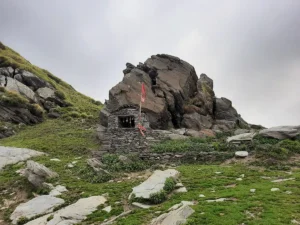
That’s why, when we finally reached the top, it felt almost unreal. Gratitude flooded my heart, and I was reassured that we could now proceed to Jalsu Pass safely. The panoramic view from the top in all four directions was awe-inspiring. The lofty peaks of the Dhauladhar range stood distinctly visible.
Our destination, Jalsu Pass, lay right before our eyes. After taking a ten-minute rest at Chunji Top, we embarked on the onward journey.
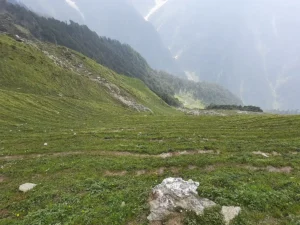
Chunji Top To Jalsu Pass
The trail from Chunji Top to Jalsu Pass, covering approximately 1 kilometer, remained straight throughout. In just 15 minutes, we arrived at Jalsu Pass. This meadow was a picturesque expanse adorned with a vibrant array of wildflowers in various hues, reminiscent of the famous Valley of Flowers. Perched on the pass was a modest temple, and we took a moment to offer our prayers there before resting for around 15 minutes.

The towering peaks were occasionally veiled by swiftly moving clouds, and the weather displayed rapid shifts. Amidst this, our intended destination, the Jalsu Pass base came into view. The sight of our campsite was a welcome relief, filling us with joy after trekking for nearly 10 hours. After a brief pause at Jalsu Pass to soak in the surroundings, we directed ourselves towards the designated area where we were set to spend the night.
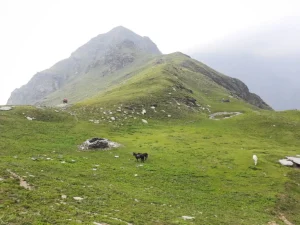
Jalsu Pass to Jalsu Pass Base Site
Jalsu Pass crowns the mountain, and a suitable camping ground lies about 2 kilometers away from the top. While it’s possible to camp at the top of Jalsu Pass, it’s not recommended due to the strong nighttime winds that could make camping there an unpleasant experience.

With the aim of spending the night at a visible hut from Jalsu Pass, we embarked on our journey and reached our destination in just half an hour. The path until this point was relatively easy, mostly downhill. The hut was managed by a Nepali gentleman who warmly welcomed us with cups of hot tea. He kindly offered us a place to stay for the night in his hut.
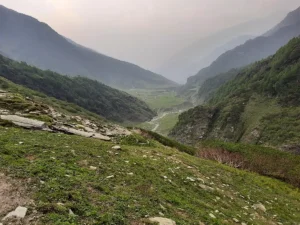
Agreeing to his offer, we inquired about the prices and settled in. By then, it was around 7 PM, and there was still plenty of light in the valley. We stepped outside the hut and took a seat to relish the splendid views. Another hut was situated nearby, housing a Gurjar family from Baijnath along with their buffaloes. Their routine involved bringing the buffaloes to higher altitudes during the summer and returning home before winter.
Smoke wafted from their hut, hinting at dinner preparation. As the sun set, the entire valley became breathtakingly beautiful, albeit chillier. We retreated to our hut and gathered around the fire. Lending a hand to the Nepali host in cooking, we listened to his tales of previous visitors. Following a hearty dinner, we settled in for the night.
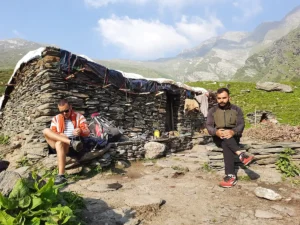
The day’s journey replayed in my mind like a movie. I remembered the challenges we faced to reach Jalsu Pass and couldn’t help but smile. It struck me that there was a moment when we almost considered turning back to Parai, and now, here I was inside the hut, reminiscing about that very thought. A sense of relief washed over me, and I drifted into a peaceful sleep.
Jalsu Pass Trek Day 3 : Return Journey to our Homes
After a restful night’s sleep, we awoke feeling refreshed. Once we had freshened up, we settled outside to witness the sunrise. As each ray of sun touched the valley, the colors around us shifted and changed. The sunrise was truly magnificent, bathing the entire valley in its warm glow. The glaciers sparkled, and the grass seemed to turn an even richer shade of green. The sun’s gentle warmth felt like a rejuvenating embrace.
Before long, the owner of the hut prepared some delicious paranthas for us. We indulged ourselves, relishing the unique experience of eating paranthas amidst the mountains, under the soothing rays of the sun.

We took a leisurely stroll across the expansive meadows, exploring nearby spots. Around 10 AM, we set out for our homes through the route of Futni Dhar.
We only wanted to explore jalsu pass however people also cross over to Chamba from this pass. People walk upto Nayagraan which is a full day’s walk from Jalsu Pass. Buses are available to chamba after nayagraan.
People of Baijnath and Nearby areas also use Jalsu Pass route to Reach Manimahesh Kailash which is a 4-5 days journey. During the Manimahesh Yatra the jalsu pass route is used by many pilgrims.
Popular Among People : Bangoru Waterfall – The Hidden Waterfall in Bir Billing
How to Do Jalsu Pass Trek
The Jalsu Pass trek offers a moderate level of difficulty, but with proper planning, it can be comfortably accomplished. The key factor before starting this trek is having someone familiar with the trail, preferably someone who has done it before.
If you’re new to trekking, it’s recommended to hire a guide who can also help carry your belongings. If you have trekking experience and know your way around the mountains, you can consider doing the trek without a guide.
Although there are huts and shops along the route and at Jalsu Pass, it’s not guaranteed that they’ll be open all the time. To be safe, bring your own camping equipment and food supplies. For booking the trek or getting more information about Jalsu Pass trek, feel free to reach out to us through the “Contact Us” section.
Jalsu Pass Trek Route
The route to Jalsu Pass from Binwanagar covers a distance of approximately 20 kilometers. The path follows these points:
Baijnath/Paprola – Utrala – Binwanagar – Forebay – Bakhlud – Parai – Kharli – Jalsu Pass
Number of Days Required for Jalsu Pass Trek
While it’s possible to complete the Jalsu Pass trek in 2 days, it’s not advisable. It’s recommended to allocate at least three days to fully enjoy and complete the trek.
Jalsu Pass in 2 Days
This schedule is designed for experienced trekkers and shouldn’t be considered by beginners.
– Day 1: Binwanagar to Jalsu Pass, covering around 20 kilometers.
– Day 2: Jalsu Pass – back to Binwanagar.
Jalsu Pass in 3 Days
This more relaxed schedule is suitable for everyone.
– Day 1: Binwanagar to Parai, a distance of 15 kilometers.
– Day 2: Parai to Jalsu Pass.
– Day 3: Jalsu Pass back to Binwanagar.
Crossing to Chamba via Jalsu Pass would require a minimum of 2 days to reach Nayagran from Binwanagar.
Best Time to Do Jalsu Pass Trek
The ideal time for this trek is during August to September when the Manimahesh pilgrimage starts. During this period, the valley is lush green and you’ll have the company of fellow pilgrims. Additionally, huts and shops are open along the way for meals and accommodation.
Essential Things to Carry on Jalsu Pass Trek
If you’re trekking independently, make sure to have camping gear and enough rations for a three-day period.
– Don’t forget to pack warm clothing like jackets, caps, mufflers, and thermals.
– Wear suitable trekking shoes.
– Remember to bring sunglasses, a hat, and sunscreen.
– A rain cover is essential for this trek.
– Pack extra pairs of socks.
– Carry a flashlight.
In conclusion, the Jalsu Pass trek offers an unforgettable journey through the stunning landscapes of the Himalayas. With its picturesque meadows, dense forests, gushing streams, and breathtaking panoramic views, this trek is a true paradise for nature enthusiasts and adventure seekers alike. The challenging yet rewarding trail tests both physical endurance and mental resilience, making it a fulfilling experience for those who embark on it.
As you traverse through the diverse terrain and immerse yourself in the serenity of the mountains, the memories forged during the Jalsu Pass trek are bound to last a lifetime. It’s not just a trek; it’s an opportunity to connect with nature’s grandeur and discover your own inner strength amidst the wilderness.
FAQ’s
Where is Jalsu Pass
Jalsu Pass stands as a crucial link between the Kangra and Chamba Districts in Himachal Pradesh, seamlessly connecting these two regions. The pass offers access from both directions, allowing trekkers to embark on their journey from either Baijnath or Nayagran. This flexibility not only showcases the pass's significance but also offers adventurers the choice to explore its beauty from diverse starting points. Whether starting from Baijnath or Nayagran, the Jalsu Pass trek promises an immersive experience through the awe-inspiring landscapes of Himachal Pradesh.
Can one go to Manimahesh Through Jalsu Pass
Yes, people go on Manimahesh Kailash yatra through Jalsu Pass. It takes minimum 4 days to reach Manimahesh through Jalsu Pass
Popular Among People : Discover Dehnasar Lake-The Captivating Lake That Grants Your Desires
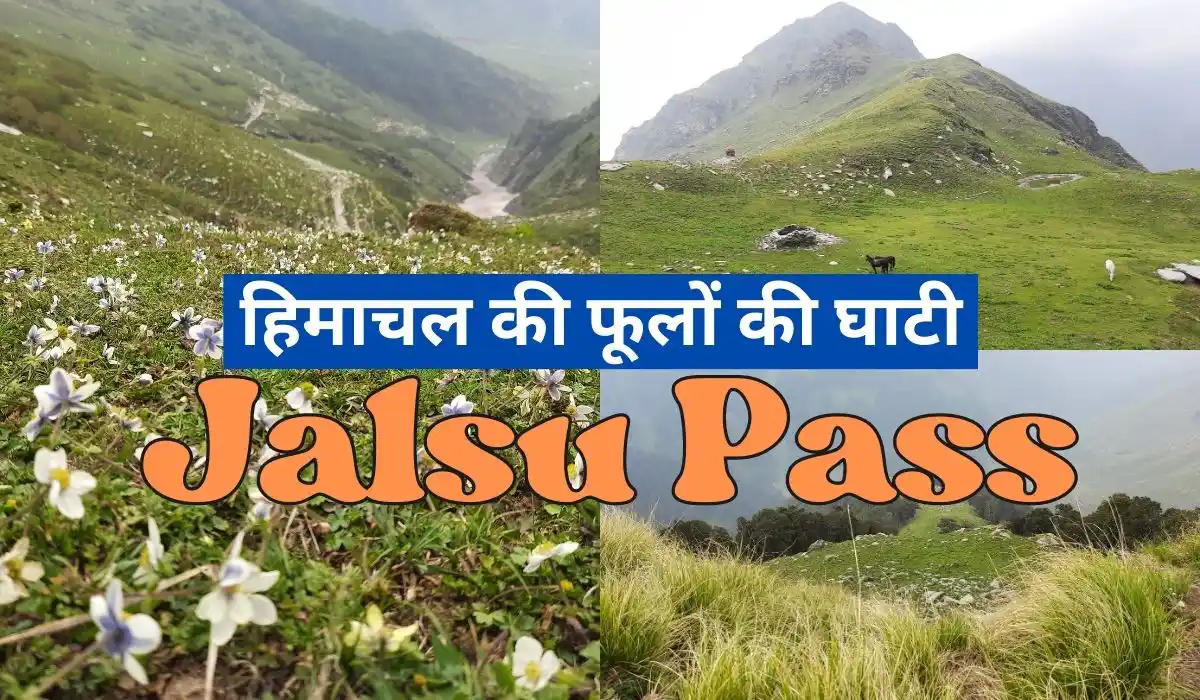
Nice Information, very well written.